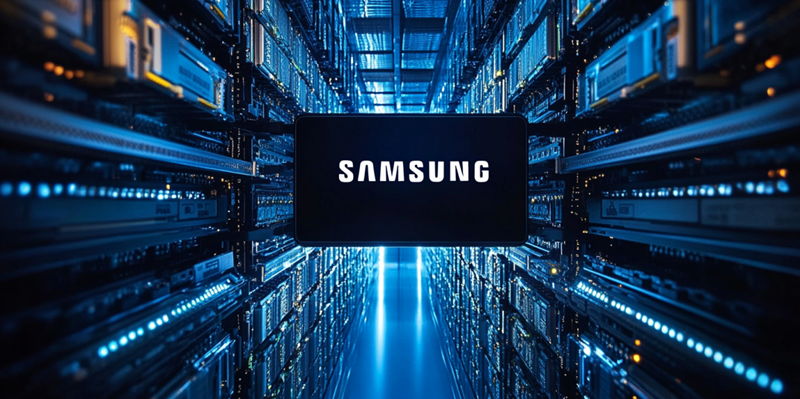Samsung has made waves in the tech world by unveiling its groundbreaking 24Gb GDDR7 RAM, a significant leap from the previous 16Gb GDDR7 modules. This development is particularly exciting as it could have profound implications for the next generation of Nvidia’s Blackwell GPUs, expected next year. The new memory promises enhanced capacity, speed, and efficiency, making it a potential game-changer in the landscape of graphics technology.
Samsung’s introduction of the industry’s first 24Gb GDDR7 RAM marks a milestone. This new memory module not only surpasses the current 16Gb GDDR7 but also sets a new benchmark for video RAM capabilities. Fabricated using a 5th-generation 10nm process, the 24Gb GDDR7 RAM offers 50% more cell density while maintaining the same package size. Each module now boasts a 3GB capacity compared to the 2GB previously offered.
This advancement in manufacturing technology doesn’t just add capacity; it also enhances the overall performance of the device. With increased cell density, the memory can handle more data at faster speeds, addressing the ever-growing demands of modern applications. As Samsung gears up to bring this innovation to the market, the industry is keenly watching how these enhancements will unfold.
A Leap in Video RAM Technology
One of the standout features of Samsung’s new GDDR7 RAM is its remarkable speed. The 24Gb GDDR7 RAM delivers an impressive 40Gbps, a 25% increase over the existing GDDR7 memory modules, which run at 28Gbps or 32Gbps. Under specific conditions, the performance could rocket to 42.5Gbps, making it a frontrunner in speed and efficiency.
The energy efficiency improvements are equally noteworthy. Samsung claims that the new RAM is 30% more power-efficient compared to its predecessors. This enhancement in power consumption is crucial, especially as devices become more power-hungry. This combination of speed and efficiency makes the 24Gb GDDR7 RAM a compelling option for high-performance applications, highlighting Samsung’s dedication to pushing the boundaries of what’s possible in memory technology.
As Nvidia prepares to launch its next-gen Blackwell GPUs, the integration of Samsung’s GDDR7 RAM could prove transformative. The new VRAM’s high-speed and power-efficient characteristics align perfectly with the demands of high-end consumer graphics cards. This could mean substantial improvements in graphical performance, especially for flagship models like the RTX 5090 Ti or possibly the 5080 Ti or Super variant.
Speed and Efficiency: The Game-Changers
Nvidia’s adoption of this advanced VRAM could set new standards in the industry, pushing the envelope in terms of both performance and efficiency. Gamers, professionals, and tech enthusiasts eagerly anticipate how these enhancements will manifest in real-world applications, potentially revolutionizing user experiences. While Samsung’s new memory is primed for heavy-duty applications, its impact on consumer-grade graphics cards can’t be underestimated.
While Samsung’s innovations hold promise for Nvidia, competitors like AMD and Intel are taking different routes. AMD’s upcoming RDNA 4 GPUs are rumored to stick with GDDR6, focusing on cost-efficiency for mid-range models. This decision highlights a strategic choice to balance performance with affordability, catering to a broader market segment.
The Implications for Nvidia’s Blackwell GPUs
Intel, on the other hand, is targeting the low-end market with its 2nd-gen Arc Battlemage graphics cards. This strategy suggests that Intel may not yet be ready to integrate GDDR7 technology, instead focusing on other priorities. These contrasting approaches underscore the diverse strategies employed by major players in the industry, each aiming to capture different segments of the market.
Samsung’s 24Gb GDDR7 RAM is set to undergo rigorous testing and validation in 2024, with commercial deployment anticipated by early 2025. This timeline aligns well with the projected release cycles of next-gen GPUs, allowing ample time for thorough evaluation and refinement. The tech community is optimistic yet cautious, watching closely as Samsung navigates this critical phase.
Differing Strategies: AMD and Intel’s Approach
Samsung has set the tech world abuzz by introducing its revolutionary 24Gb GDDR7 RAM, marking a substantial upgrade from the previous 16Gb GDDR7 modules. This advancement holds significant promise for the forthcoming generation of Nvidia’s Blackwell GPUs, anticipated next year. The new RAM offers improved capacity, speed, and efficiency, potentially transforming the graphics technology landscape.
By launching the first-ever 24Gb GDDR7 RAM, Samsung has reached a new milestone. This memory module not only outperforms the existing 16Gb GDDR7 but also establishes a new standard for video RAM. Created using a 5th-generation 10nm process, the 24Gb GDDR7 RAM boasts 50% more cell density while retaining the same package size. Each module now offers a 3GB capacity, an improvement from the previous 2GB.
This leap in manufacturing technology enhances both capacity and overall device performance. Increased cell density allows the memory to process more data at higher speeds, meeting the rising demands of modern applications. As Samsung prepares to introduce this innovation to the market, the entire industry is eagerly anticipating the impact of these advancements. This breakthrough is likely to influence the future of graphics technology and beyond.

